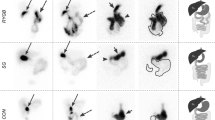Abstract
The intraluminal changes of bile acids were studied in 42 patients with intestinal obstruction, treated from 1978–1982. Twenty-two patients received surgical treatment and twenty were treated conservatively. Bile acid analysis of the intestinal contents was performed by thin-layer and gas-liquid chromatography. A marked reduction of bile acid concentration was observed before treatment. A decreased percentage of deoxycholic acid, a lowered G:T ratio, and presence of deconjugated bile acids were also present. After relief and/or removal of the obstruction, the concentration of bile acids, the percentage of deoxycholic acid, and the G:T ratio increased. Bile acid deconjugation decreased immediately after surgical treatment but was not affected by conservative treatment. We conclude that bile acid metabolism is altered quantitatively and qualitatively in patients with an intestinal obstruction.
Similar content being viewed by others
References
Nadrowski LF. Pathophysiology and current treatment of intestinal obstruction. Rev Surg 1974; 31: 381–407.
Matsukura S, Shirota A. Clinical and experimental studies on the cause of death in acute intestinal obstruction with special reference to intestinal bacterial flora, especially coli-group bacilli. J Clin Surg 1966; 21: 321–329. (in Japanese)
Iwama A. Clinical and experiemntal studies on acute strangulated intestinal obstruction. Special reference to the bacterial lethal agent Nippon Geka Gakkai Zasshi (J Jpn Surg Soc) 1975; 76: 405–419. (in Japanese)
Onda M. Studies on intestinal obstruction—Special reference to pathophysiological significance of bile—(Author’s translation) Nippon Geka Gakkai Zasshi (J Jpn Surg Soc) 1967; 68: 237–258. (in Japanese)
Matern S, Gerok W. Pathophysiology of the enterohepatic circulation of bile acids. Rev Physiol Biochem Pharmacol 1979; 85: 125–204.
Sykes PA, Boulter KH, Schofield PF. Alteration in small-bowel microflora in acute intestinal obstruction. J Med Microbiol 1976; 9: 13–22.
Bishop RF, Anderson CM. The bacterial flora of the stomach and small intestine in children with intestinal obstruction. Arch Dis Child 1960; 35: 487–491.
Bessho A. The effect of intestinal bacteria on acute simple intestinal obstruction—with special reference to germ free animal Nippon Geka Gakkai Zasshi (J Jpn Surg Soc) 1981; 82: 96–107. (in Japanese) (English Abst.)
Hill MJ, Drasar BS. Degradation of bile salts by human intestinal bacteria. 1968; Gut 9: 22–27.
Shindo K, Fukushima K. Deconjugation of bile acids by human intestinal bacteria. Gastroenterol Jap 1976; 11: 167–174.
Gänshirt H, Koss FW, Morianz K. Untersuchung zur quantitaiven Auswertung der Dünnschichtchromatographie. 2. Mitteilung: Trennung und Bestimmung von Gallensäuren. Arzneimettelforsch 1960; 10: 943–497.
Hofmann AF. Thin-layer adsorption chromatography of free and conjugated bile acids on silicic acid. J Lip Res 1962; 3: 127–128.
Ohkawa H, Hirabayashi N, Maeda M, Ueno M, Matsuoka S, Asou S, Iwasaki M. Effect of ursodeoxycholic acid on secretion and composition of bile. (Author’s translation) Clin Rep 1976; 10: 40–56. (in Japanese)
Bruusgaard A, Thaysen EH. Increased ratio of glycine/taurine conjugated bile acids in the early diagnosis of terminal ileopathy. Acta Med Scand 1970; 188: 547–548.
Hafkenschied JCM, Hector MPC. An enzymic method for the determination of the glycine/taurine ratio of conjugated bile acids in bile. Clin Chem Acta 1975; 65: 67–74.
Garbutt JT, Heaton KW, Lack L, Tyor MP. Increased ratio of glycine- to taurine-conjugated bile salts in patients with ileal disorders. Gastroenterology 1969; 56: 711–720.
Parkin DM, O’Moore RR, Cussons DJ, Warwick RRG, Pooney P, Percy-Robb IW, Shearman DJC. Evaluation of the “breath test” in the detection of bacterial colonisation of the upper gastrointestinal tract. Lancet 1972; 2: 777–780.
Ishiguro N, Fukushima T, Shimada H, Kobayashi M, Tsuchiya S. Bile acid alterations after biliary tract surgery. Nippon Shokaki Geka Gakkai Zasshi (J Jpn Gastroent Surg) 1977; 10: 666–671. (in Japanese)
Donaldon RM Jr. Small bowel bacterial over-growth. Adv Intern Med 16: 1970; 191–212.
Binder HJ, Filburn B, Flock M. Bile acid inhibition of intestinal anaerobic organisms. Am J Clin Nutr 1975; 28: 119–125.
Northfield TC, Drasar BS, Wright JT. Value of small intestinal bile acid analysis in the diagnosis of the stagnant loop syndrome. Gut 1973; 14: 341–347.
Fukushima T, Ishiguro N, Tsujinaka Y, Yamazaki R, Tsuchiya S. Bile acid deconjugation in intestinal obstruction studied by breath test. Jpn J Surg 1977; 7: 73–81.
Author information
Authors and Affiliations
Rights and permissions
About this article
Cite this article
Ishiguro, N., Fukushima, T. & Tsuchiya, S. Bile acid metabolism in patients with non-strangulated intestinal obstruction. The Japanese Journal of Surgery 14, 278–285 (1984). https://doi.org/10.1007/BF02469642
Received:
Issue Date:
DOI: https://doi.org/10.1007/BF02469642




